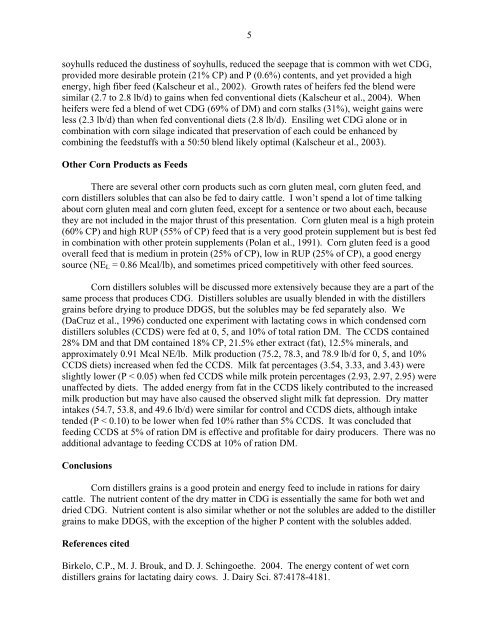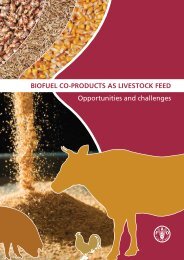Distillers Grains Feeding Recommendations. - Distillers Grains By ...
Distillers Grains Feeding Recommendations. - Distillers Grains By ...
Distillers Grains Feeding Recommendations. - Distillers Grains By ...
Create successful ePaper yourself
Turn your PDF publications into a flip-book with our unique Google optimized e-Paper software.
5soyhulls reduced the dustiness of soyhulls, reduced the seepage that is common with wet CDG,provided more desirable protein (21% CP) and P (0.6%) contents, and yet provided a highenergy, high fiber feed (Kalscheur et al., 2002). Growth rates of heifers fed the blend weresimilar (2.7 to 2.8 lb/d) to gains when fed conventional diets (Kalscheur et al., 2004). Whenheifers were fed a blend of wet CDG (69% of DM) and corn stalks (31%), weight gains wereless (2.3 lb/d) than when fed conventional diets (2.8 lb/d). Ensiling wet CDG alone or incombination with corn silage indicated that preservation of each could be enhanced bycombining the feedstuffs with a 50:50 blend likely optimal (Kalscheur et al., 2003).Other Corn Products as FeedsThere are several other corn products such as corn gluten meal, corn gluten feed, andcorn distillers solubles that can also be fed to dairy cattle. I won’t spend a lot of time talkingabout corn gluten meal and corn gluten feed, except for a sentence or two about each, becausethey are not included in the major thrust of this presentation. Corn gluten meal is a high protein(60% CP) and high RUP (55% of CP) feed that is a very good protein supplement but is best fedin combination with other protein supplements (Polan et al., 1991). Corn gluten feed is a goodoverall feed that is medium in protein (25% of CP), low in RUP (25% of CP), a good energysource (NE L = 0.86 Mcal/lb), and sometimes priced competitively with other feed sources.Corn distillers solubles will be discussed more extensively because they are a part of thesame process that produces CDG. <strong>Distillers</strong> solubles are usually blended in with the distillersgrains before drying to produce DDGS, but the solubles may be fed separately also. We(DaCruz et al., 1996) conducted one experiment with lactating cows in which condensed corndistillers solubles (CCDS) were fed at 0, 5, and 10% of total ration DM. The CCDS contained28% DM and that DM contained 18% CP, 21.5% ether extract (fat), 12.5% minerals, andapproximately 0.91 Mcal NE/lb. Milk production (75.2, 78.3, and 78.9 lb/d for 0, 5, and 10%CCDS diets) increased when fed the CCDS. Milk fat percentages (3.54, 3.33, and 3.43) wereslightly lower (P < 0.05) when fed CCDS while milk protein percentages (2.93, 2.97, 2.95) wereunaffected by diets. The added energy from fat in the CCDS likely contributed to the increasedmilk production but may have also caused the observed slight milk fat depression. Dry matterintakes (54.7, 53.8, and 49.6 lb/d) were similar for control and CCDS diets, although intaketended (P < 0.10) to be lower when fed 10% rather than 5% CCDS. It was concluded thatfeeding CCDS at 5% of ration DM is effective and profitable for dairy producers. There was noadditional advantage to feeding CCDS at 10% of ration DM.ConclusionsCorn distillers grains is a good protein and energy feed to include in rations for dairycattle. The nutrient content of the dry matter in CDG is essentially the same for both wet anddried CDG. Nutrient content is also similar whether or not the solubles are added to the distillergrains to make DDGS, with the exception of the higher P content with the solubles added.References citedBirkelo, C.P., M. J. Brouk, and D. J. Schingoethe. 2004. The energy content of wet corndistillers grains for lactating dairy cows. J. Dairy Sci. 87:4178-4181.
















